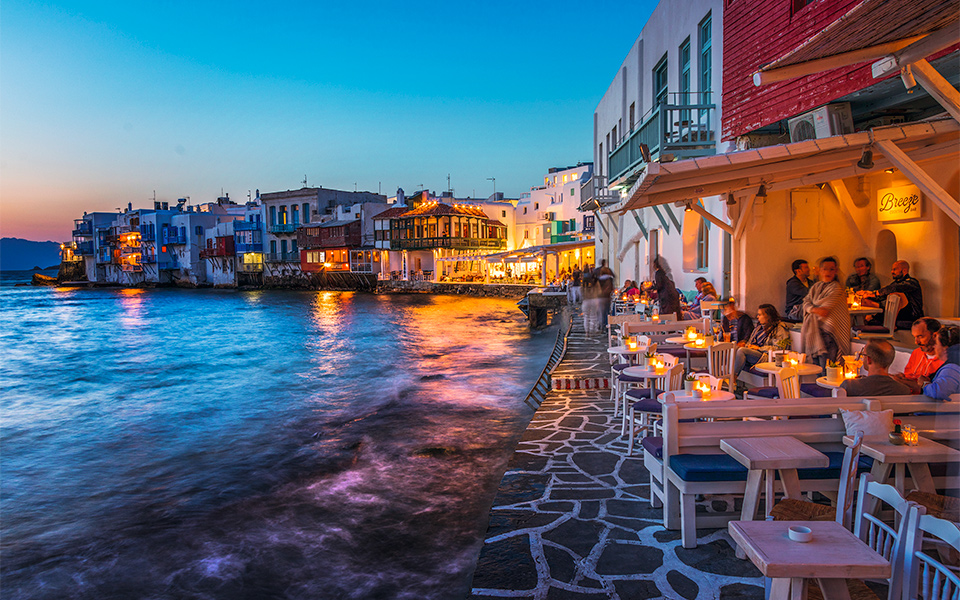Aesthetics and Experiences in Chora
White sugar-cube buildings, embellished with colorful doors and window frames, crowd along narrow streets, all the way down to the water’s edge. Squares and courtyards are few and far between; in total, only 10% of Chora hasn’t been built upon. The low stone walls, staircases, whitewashed flagstones and potted plants create the impression that the town is one large outdoor living room where all the action is out in the open.
People meet, flirt, shop, eat, drink or simply stare as crowds of fashionistas, partygoers or cruise ship travelers parade through. The way the town is built, however, also offers protection from the strong Etesian wind (“meltemi” in Greek) that can buffet the island mercilessly throughout July and August. In Little Venice (pictured above), with its views of the island’s iconic windmills, you can enjoy one of the world’s most famous sunsets while sipping on cocktails.
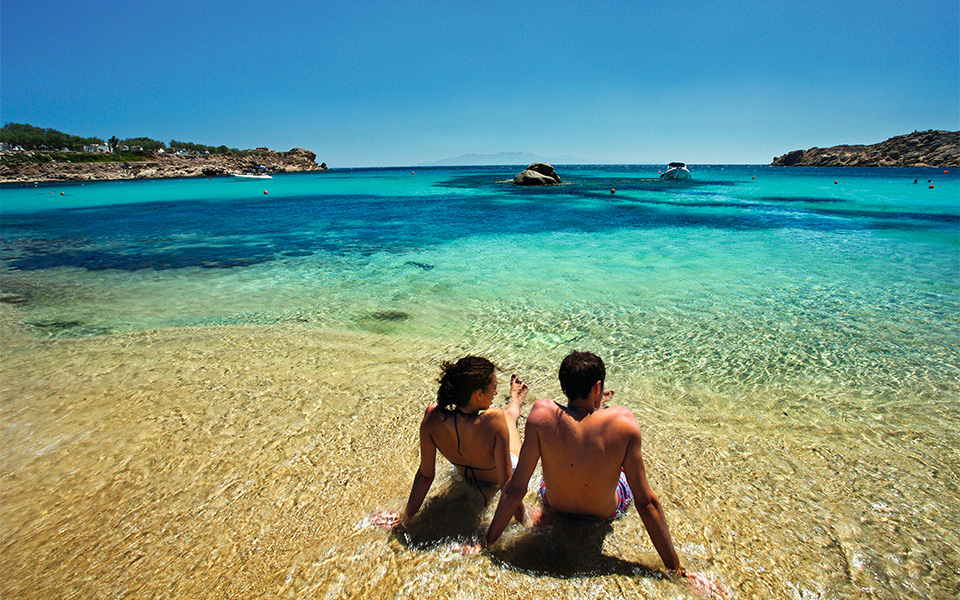
© Getty Images/Ideal Image
LIFE’S A BEACH
Trendy beaches with sophisticated bars and restaurants, thumping music and the scent of suntan oil hanging in the air, or remote stretches of sand where the breeze carries wafts of wild thyme? Mykonos has it all. At the more popular beaches – like Lia, Ornos, Paradise and Super Paradise, Ai Giannis, Aghios Stefanos, Elia, Kalafatis, Kalo Livadi, Paraga, Agrari, Platis Gialos, Aghia Anna and Panormos – don’t expect to grab a sun lounger set without a reservation; prices range from €15 (Sunrise Mykonos at Agrari) to €120 (Nammos at Psarou).
Not your thing? Head for the unsullied shores on the east and west sides of the island or on the “wild” north. Fokas and Aghios Sostis are two large golden beaches flanked by rocks; if you forgo a swimsuit, no one will raise an eyebrow. Tigani, Tsagari and Fragia are for the even more adventurous, as access is via dirt roads followed by something of a hike. For sunset swims, head to Kapari or Houlakia. For shade under the trees, go to Meriha and for swimming off rocks, head to Karapeti. Perhaps the least known beach is Loulos, next to the busy Kalo Livadi.
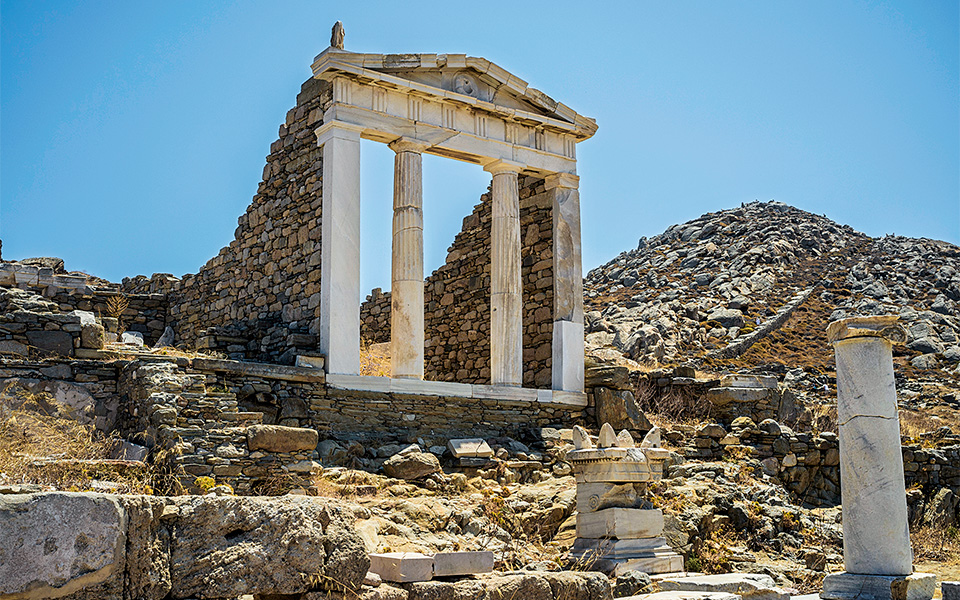
© Getty Images/Ideal Image
Delos – THE SACRED ISLAND
Only a 30-minute boat ride from Mykonos, Delos is at the center of the rough circle (kyklos in Greek) formed by the islands of the central Aegean – a geographical arrangement reflected in the name Cyclades. The mythical birthplace of the deities Apollo and Artemis, Delos flourished between 166 and 69 BC, becoming one of the most important trading centers of antiquity, with a population that reached 30,000 – impressive for a stretch of land only 5k long and 2.3k wide.
The island subsequently went into decline and was all but forgotten until 1873, when the archaeological digs by the French Archaeological School triggered intense international interest. Today, Delos is included in UNESCO’s World Heritage List, and is one of Greece’s most important archaeological sites, certain to captivate anyone willing to let their imagination run wild and envisage the city-state that once thrived here. There are no permanent residents on the island, and spending the night is not permitted. The boats that transport visitors typically allow four hours to tour the site.
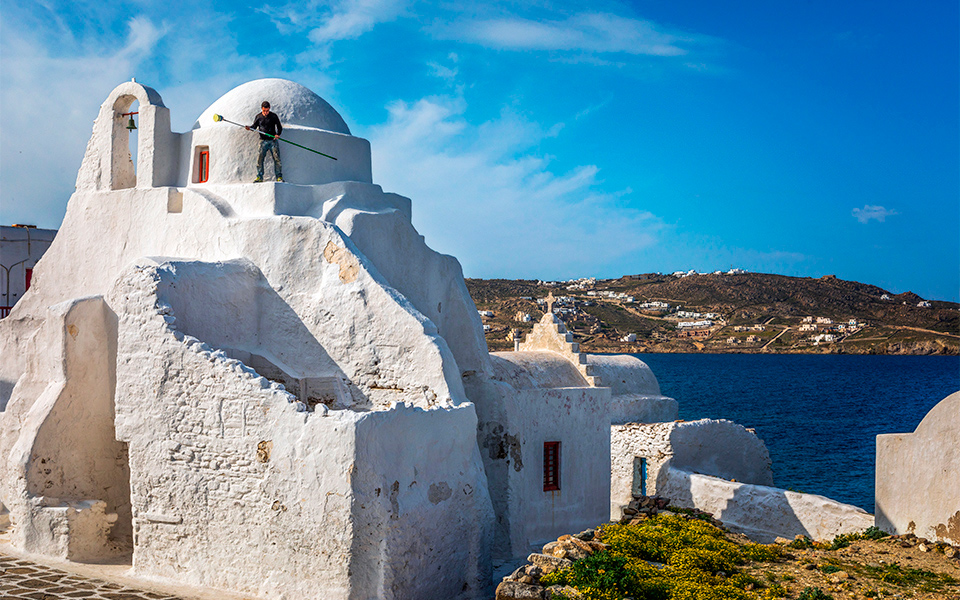
© Perikles Merakos
THE “ACROPOLIS OF MYKONOS”
Considered by many to be one of the most beautiful buildings in the world and often referred to as the “Acropolis of Mykonos,” Paraportiani Church is located in the Kastro district, near the edge of the port. Its name is derived from the small side entrance (“para-porta”) of the medieval castle, near which it was built. What sets it apart is that it’s not really one church, but a complex of churches built at different levels over a 400-year period.
At the lowest level, which is 1,000 years old, four churches share the same space and are dedicated to the saints Aghioi Anargyroi, Aghios Efstathios, Aghios Sozontas and Aghia Anastasia. The Byzantine Church of Panaghia (the Virgin Mary) was built on the second level and is characterized by its exceptional plasticity, its asymmetry and arched bell tower. Another unique element is that the entryway is at the eastern end of the building, whereas in all other orthodox churches it faces west.
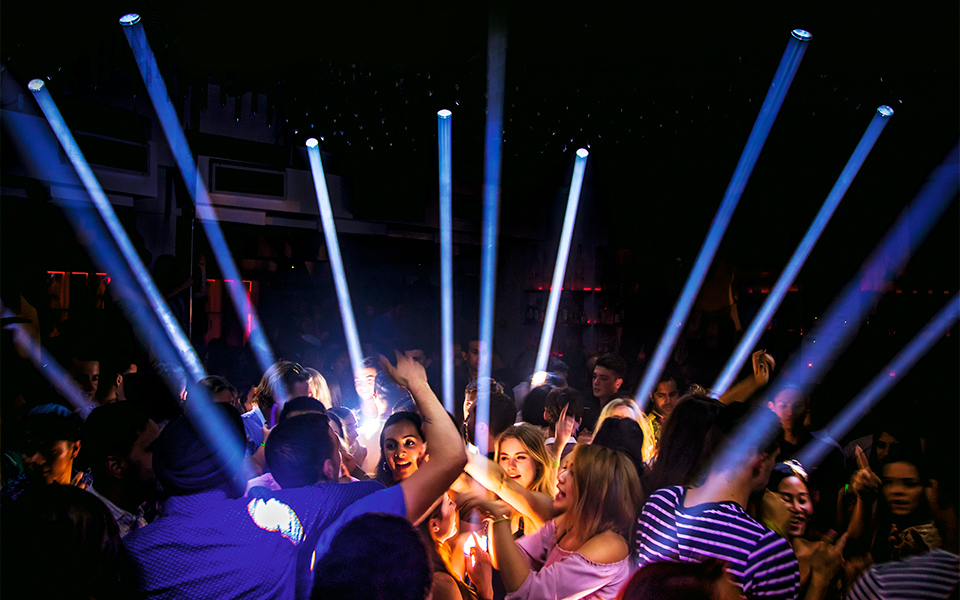
© Perikles Merakos
NEITHER IBIZA NOR CÔTE D’AZUR
In reality, Mykonos is neither the jet-set island where champagne corks pop every second and private helicopters swarm like locusts (see Côte d’Azur) nor an island of pure hedonism where legions of clubbers dance half-naked in a state of ecstasy from morning to the next morning (see Ibiza).
It’s true that Mykonos has elements of both, but it also has much more to offer: an early virgin cocktail with Greek fruit while walking barefoot in fine sand, an old-school (i.e. pre-Tinder) style flirtation as you sip an elegant martini or a world-class aperitif in Chora shortly before a fine dinner, and hours of dancing – beginning with R&B at 2 in the morning, followed by house music at 4 and Greek folk songs at sunrise. Mykonos is a small place with an enormous range. And that’s what makes it special. Soak it up!
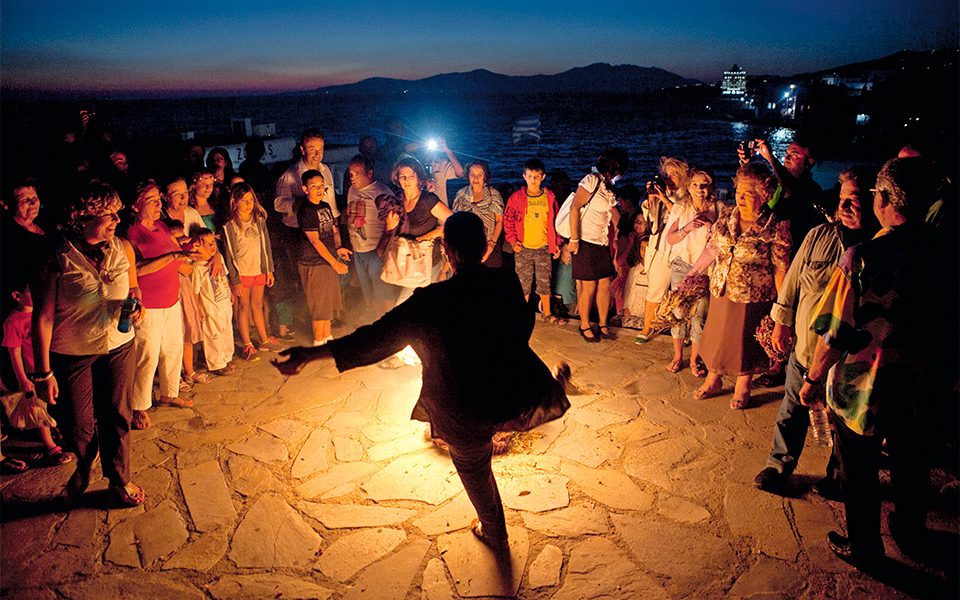
© Kaity Fouski
PARTY LIKE A LOCAL
Despite the sweeping societal changes brought about by the island’s frontline position in the Greek tourism boom, the Mykonians continue to cherish their traditions and their communal identity, both of which are indelibly linked to the Christian Orthodox faith. One of the best ways to see how this works is at a church fair, or “panigiri,” which is not just a celebration of an important religious occasion, but also an opportunity to strengthen community spirit and bonds with the past.
There are around 600 churches on Mykonos today and each will hold a panigiri, big or small, on the day their namesake is celebrated. On the eve of the saint’s day, the church will be whitewashed, local delicacies will have been prepared and the wine will start to flow. During the summer fairs, rows upon rows of tables are set up in the church courtyards and, depending on the turnout, this makeshift dining room may even spill over into an adjacent field or street.
The feast starts after the evening mass and, once the musicians take out their traditional instruments – like the tsabouna (bagpipes) and the toubaki (a drum) – and the crowd starts dancing, things usually carry on well into the wee hours. The smaller fairs tend to be more interesting, because they often retain their sense of occasion and modesty, not turning into the drunken party that some of the larger ones can become. Don’t be shy about dropping by. Once you’re there, no one will let you leave before you’re wined and dined. It’s always a good idea to bring a bottle of wine or a dessert to pay your respects to your hosts, but even more importantly, bring a healthy appetite for fun.
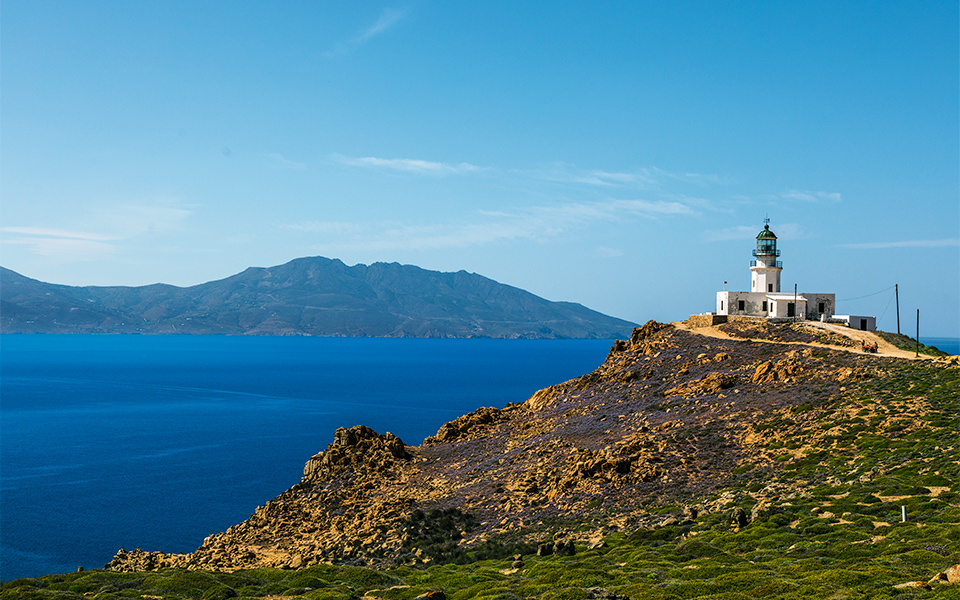
© Perikles Merakos
ESCAPE THE CROWDS
If your aim is to steer clear of parties, then the best thing to do is to rent a car and visit Mykonos’s hinterland. With few trees, it’s a wild and barren landscape dominated by granite boulders fringed with large prickly pear and dotted with farmsteads and churches.
The rocky ground – the reason for the Mykonians’ relative poverty in earlier centuries when wealth was linked to local agricultural production – is, according to one reading, the source of the island’s name. (Etymologically “mykon” derives from a word meaning “a pile of rocks,” while according to Greek mythology, the island was where Herakles buried the last of the remaining giants under huge boulders during the Gigantomachia, the war between the gods and the giants.) Drive to the Armenistis Lighthouse to watch the sunset, or along the roads that lead to the northern side of the island from Myrsini to Merhia, or hike to the peak of Profitis Ilias, the island’s highest point.
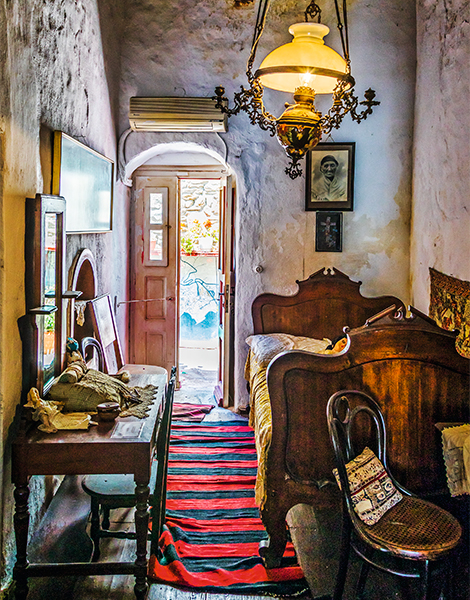
© Perikles Merakos
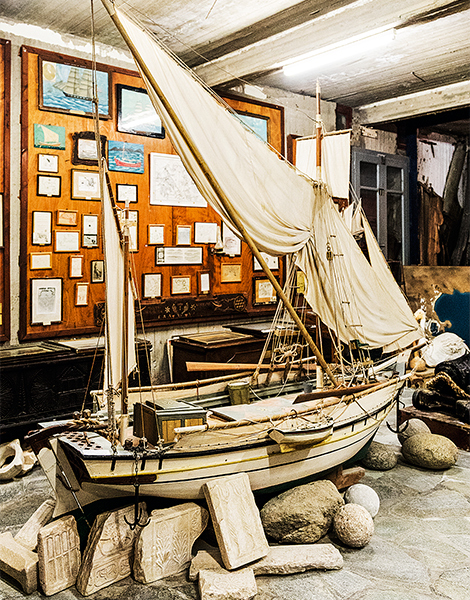
© Perikles Merakos
STEP INTO THE PAST
Enter the 19th-century mansion that houses the Aegean Maritime Museum to see models of ships, antique nautical instruments and the mechanism of Armenistis lighthouse, an award-winning innovation at its time that guided ships for almost a century. Right next door is Lena’s House, a reconstruction of a typical Mykonian townhouse. The original owner may have died in 1968, yet as you walk through the rooms you’ll feel that she only just stepped out. Family heirlooms, furniture and everyday items all seem to be left untouched.
Lena’s House is an annex of the Folklore Museum of Mykonos, which is located next door to the famed Paraportiani Church. It is housed in one of the oldest two-story homes on the island, built on the ruins of a Byzantine castle, still visible from the basement. In the museum, you can find exhibits of folk art as well as items brought back by local sailors from their trips around the world. Among the highlights are wonderful 18th-century Venetian screens, 200-plus votive offerings and baptismal pins, and solid gold traditional Mykonian earrings.
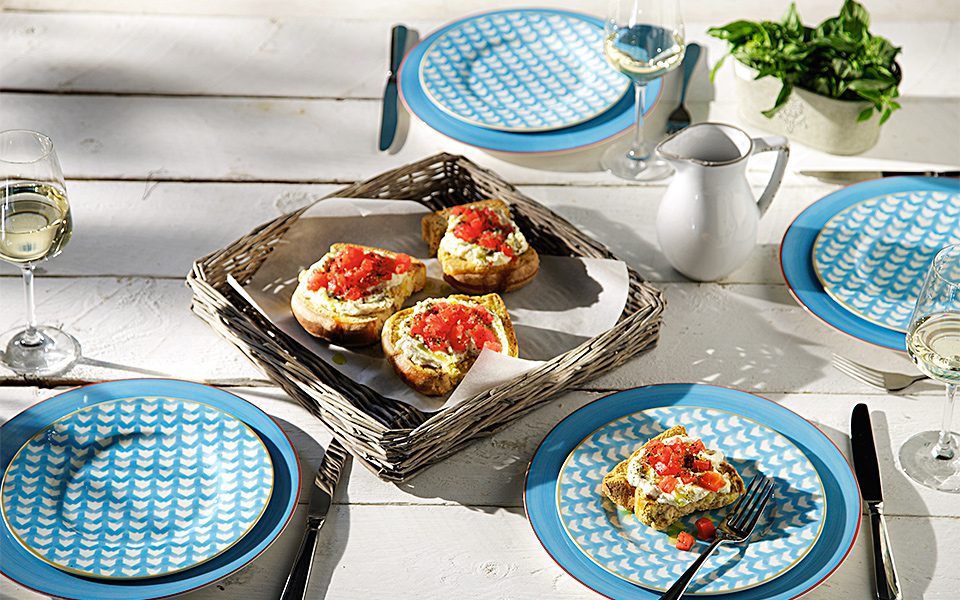
© Photo: G. Drakopoulos, Food Styling: Tina Webb
TRY IT, IT’S A MUST
In order to sample Mykonos’ most famous dish, you don’t need to book a table in advance. Mostra is made with rusk and cheese, humble ingredients that speak of leaner times and Mykonos’s relatively poor soil.
You can even make it yourself: take a barley rusk, dampen it with a very small amount of water, spread some soft and sharp kopanisti cheese, and add a juicy tomato cut into small or large pieces. Drizzle with olive oil and sprinkle with a pinch dry oregano. The tang of the sharp cheese is balanced by the sweetness of the tomato, and the combination is best washed down with a glass of ice-cold ouzo or any other refreshing summer drink.

